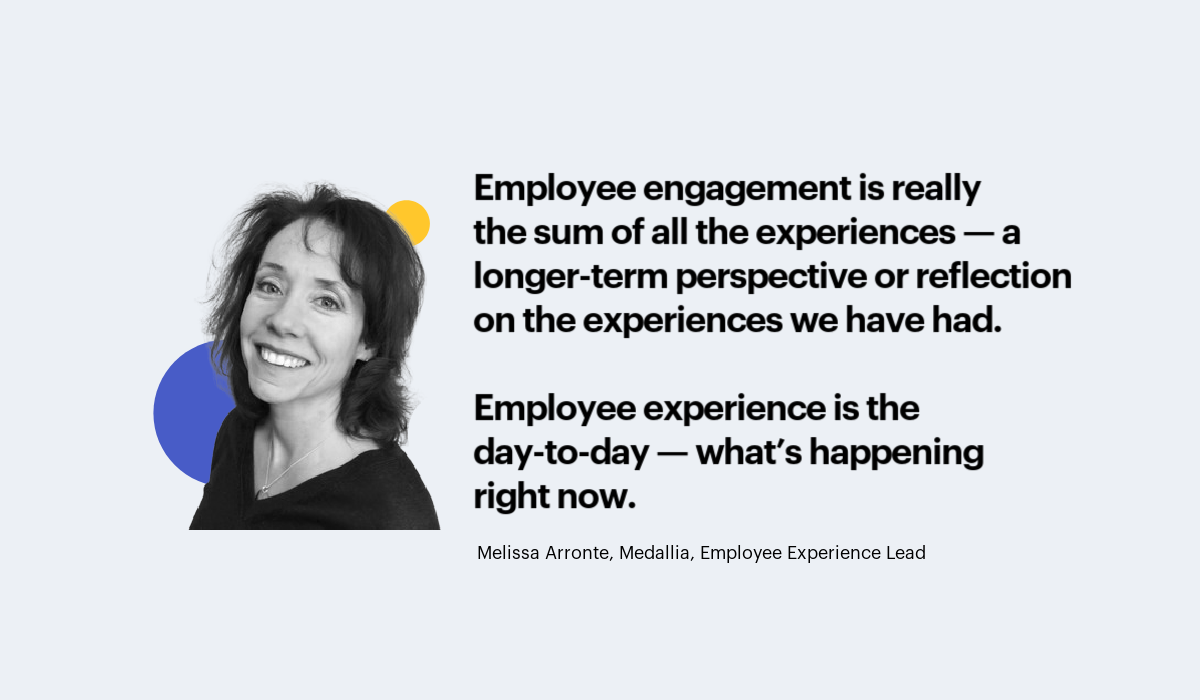To Keep Service Industry Workers—Try Listening
The restaurant, retail, and hospitality sectors are struggling amid a serious labor shortage. The key to adapting and thriving? Listening to workers' needs.

Medallia’s Employee Experience lead Melissa Arronte and Jay Forman EX Director recently spoke with Visier’s VP of People Analytics Ian Cook about how businesses in the restaurant, retail, and hospitality sectors can adapt to the ongoing worker shortage. Melissa, Jay and Ian share effective approaches not only to hire the right people, but to improve their experience in order to retain them for longer.
An industry-wide obstacle
Businesses throughout the retail, restaurant and hospitality sectors are seeing their ability to function and meet business goals seriously impeded by the ongoing labor shortage.
Companies have tried all kinds of tactics to attract and retain workers, from offering signing bonuses to writing anti-poaching clauses into their contracts. Forman even witnessed an executive at one major airport send out a facility-wide directive to all onsite businesses — ”stop stealing each others’ staff.”
Faced with pervasive, unavoidable worker shortages, many companies are being forced to reduce their hours, overburden their existing staff, or even close altogether — and the issue isn’t going away.
Leaky-bucket syndrome
Understandably, with the shortage has come a hyperfocus on attracting as many applications as possible for never-ending open roles. But Cook and Arronte suggest that focusing on retention might be more impactful for businesses.
Not only can boosting retention have a profound impact on staffing problems, but rather than trying to change the external labor market, it’s more directly in employers’ control. “Right now, everyone is so focused on finding candidates that it’s creating a blind spot around an area they can actually control, and that’s retention,” Forman explains. “Call it the leaky bucket syndrome — if they’re losing candidates faster than they can find them, the idea is that if you’re not focused on retention, you’ll always be focused on attraction.”

All about listening
The right way to create exceptional employee experiences is actually very intuitive — it’s by listening to their needs. In the workforce, Arronte commonly sees staffing issues that could have been avoided, had management been more closely attuned to their workers’ challenges.
“Perhaps the most sobering example came just a couple of weeks ago, when the entire staff of a major fast food chain just up and quit,” shares Forman. The temptation is to assume that it’s all simply related to pay, but… the manager said she had often worked up to 60 hours a week, and eight of her coworkers followed her lead, all of them complaining about the understaffed restaurant. I can’t help but wonder if this situation could have been avoided if the leadership team had been a little more curious, acted a little sooner, and a little more frequently.”
And this listening needs to happen consistently — in this climate, engagement surveys a few times a year simply aren’t enough.
“It’s like driving cross country … and constantly looking at the rear view mirror through a pair of binoculars,” Forman says of yesterday’s employee engagement strategies. ”You have no awareness of the people in the car with you, or how to anticipate the road ahead. Life in today’s workplaces changes by the hour or minute. Employees are in the perfect position to be our eyes and ears — if we’ll only listen.”

Employee experience starts in the pipeline
For businesses serious about addressing staff shortages and retention, this focus on experience must start early, during the candidate application process.
“One thing we can do is understand from employees who are applying how it’s happening for them,” says Cook. “What is happening? Are we taking too long to get back to them? Are they not understanding the position? Is the process difficult?”
If candidates see that their potential employer cares about their needs as early as the application process, they’re being introduced to their workplace culture as one that centers their experience.
Addressing retention early
Once candidates are brought onboard, a similar level of engagement needs to be maintained, or workplaces risk damaging these new, growing relationships.
“There’s an enormous amount of investment and contact with an employee in that pre-hire state,” says Cook. “If somebody then starts, and there’s not that same connection as they ramp, they’ll see it as, you paid lots of attention when you sold me, but you paid no attention after I bought.”
While a typical HR onboarding process would be to conduct an engagement survey after 90 days, in today’s labor market Cook sees that as woefully inadequate. “If you actually start to look at your event data, is it ninety days when people leave?” he asks. “Ninety days is this assumed standard, but why follow it if the data is telling you something different? Maybe it’s thirty days, twenty-five, or somewhere in between. So, is there a way to use that information so that you can then change the communication and engagement with those individuals, to then change the outcome?”
Arronte agrees. “We found through our research that, even reaching out at the end of the first week and asking if the job met their expectations they had when they’re hired was very impactful. We found that simply asking, with a very short survey to new hires about how things are going, was very predictive of turnover as early as the first week.”
Building an employee-centric culture
Of course, this level of concern with worker satisfaction must extend to all workers, not just the recently hired. But when trying to measure employee satisfaction, Cook and Arronte caution against falling into two common traps.
First, efforts to gather information must center the employee’s concerns, rather than those most relevant to the company. “A lot of companies run annual engagement surveys, but it’s more often focused on asking the employee about things the company delivers, so the company can improve,” explains Arronte. “We call that the company view, and that’s valuable, but what we’re looking to do is understand what’s happening from the employee’s perspective.”
Secondly, data collection must be ongoing, to offer true insight into granular, day-to-day workplace experiences. For Cook and Arronte, this is the difference between employee engagement, and employee experience. “We need to separate the two,” says Arronte. “Employee engagement is really the sum of all the experiences — a longer-term perspective or reflection on the experiences we have had. Employee experience is the day-to-day — what’s happening right now.”

Understanding experiences with analytics
Additionally, as well as building this kind of data collection into daily workflows on a consistent, ongoing basis, companies should supplement it with as much context and supporting detail as possible. One way to do this is by using the combination of Medallia’s survey tools and Visier’s people analytics.
“Part of what’s special about Medallia’s Employee Experience solution is the ability to enrich feedback from surveys with what we call signals, and that’s really the value of bringing in Visier,” says Arronte. “Something simple we might add from Visier could be whether the employee is on a team with higher than average employee relations issues or higher than average recognition awards. That’s a signal that gives us some information about the employee’s environment, and helps us understand their experience.”
Inspiring workplaces retain their people
At the end of the day, these techniques are all aimed at helping workplaces be as attractive as possible to candidates, and as inspiring as possible for their employees. By deeply understanding their peoples’ needs and motivations, owners and managers can use them to shape their businesses’ processes and operations.
For these two experts, the ultimate goal is to attract not just any employees, but those who truly love their jobs. By treating these valuable employees well, they may then speak highly of their employer to their own networks, attracting even more potential team members.
“Who are your people that love the job?” asks Cook. “If you can bring that core, they’ll bring their friends, their community, more people like them. You might not attract four hundred people tomorrow, you’re slowly building a population that actually supports your business long term.”
Get the Outsmart newsletter
You can unsubscribe at any time. For more information, check out Visier's Privacy Statement.


